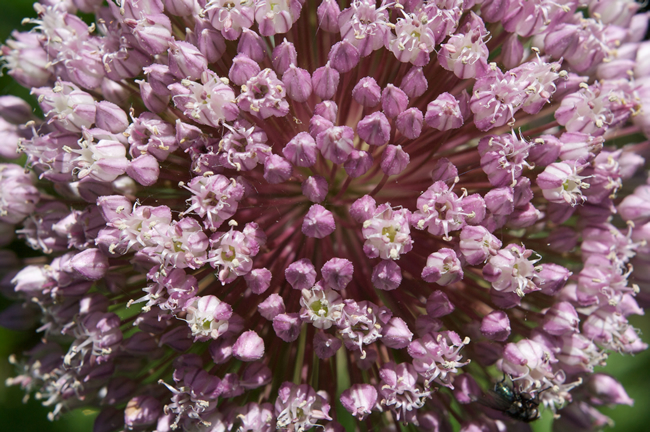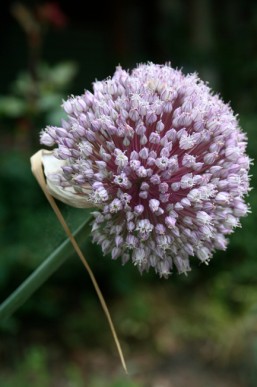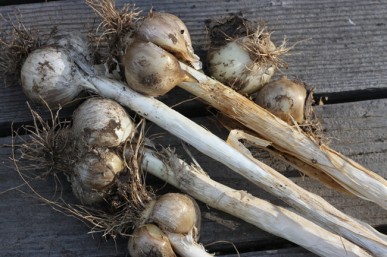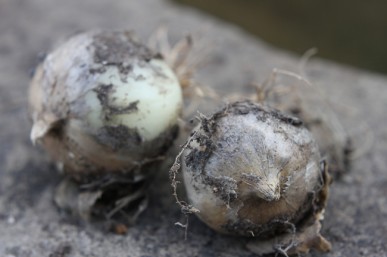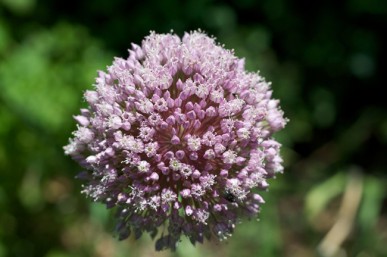Elephant garlic, also commonly called Russian garlic, is occasionally found listed in seed and bulb catologues and seed saver lists. In some regions it is found naturalised on old house sites and it is a welcome, or sometimes, unwelcome inhabitant of many suburban gardens – but it is not garlic.
So what is it? Its botanical name is Allium ampeloprasum (Ampeloprasum Group) ‘Elephant Garlic’ and it is actually a close relative of the leek, A. ampeloprasum (Porrum Group). It is only more distantly related to true garlic (A. sativum). Other common names are giant garlic, great-headed garlic, Levant garlic, Yorktown onion, and in French, ail d’orient, and German, pferdknoblauch.
A. ampeloprasum is the wild plant from which both elephant garlic and leeks are derived. It is native to Southern Europe, North Africa, Asia Minor and parts of Russia, where it grows on dry, rocky or sandy ground and near cultivated land. The specific name ampeloprasum comes from the Greek words ampelos and prason which mean a vine and leek respectively, signifying that this leek-like plant grew among grape vines. They may have self-sown from the wild, or perhaps they were an early attempt at companion planting. Allium species have been used for centuries to protect more tender plants from hungry insects. Elephant garlic bulbs have been collected from the wild and from gardens for many centuries. A wild English variety is often found in places associated with early Christian sites and may have originally been cultivated by the monks who lived there.
Elephant garlic looks superficially like a giant form of garlic, hence the name. The leaves are large, blue-green and linear with a central dividing rib. In early or mid-summer, from the centre of the leaves, a solid, cylindrical flower stalk grows to a height of a tall man. Flower heads, only slightly smaller than soccer balls, form singly at the top of the flower stalks in spring and summer. These flower heads are covered by a single long-beaked spathe which resembles a swan’s head and splits to reveal the densely-packed pink or mauve flowers. Both the flower buds and heads look dramatic at the back of a mixed border.
Elephant garlic is grown from cloves or rounds planted in autumn, winter and spring in mild climates, or autumn and spring in cool climates. Plant the cloves and rounds blunt or root ends down about 30 centimetres apart. The tops of the bulbs should be about 5 centimetres below the soil surface. Plants do best in a rich, deeply cultivated bed and like full sun and well-drained soil, but they are very hardy and really need no special treatment. Regular harvesting and/or confinement to a definite bed ensures that elephant garlic will not become a weed. It grows from the tropics to temperate Australia and tends to grow taller and to have a stronger flavour in cooler regions.
Elephant garlic bulbs form under the soil, can reach 10 centimetres in diameter and consist of 3 to 6 large cloves. External to these cloves are anything from one to twenty small bulblets, up to one centimetre across, with a flat side. Plants that do not flower often form a single, large, symmetrical clove, also known as a round, up to 4 centimetres in diameter, rather than a bulb. Plants grown from rounds or from very large cloves, frequently produce a large bulb with several cloves and a flower stalk. Plants grown from a smaller clove or from a bulblet usually produce a round and no flower stalk. So elephant garlic tends to alternate between the production of cloves and the production of rounds, and to go to seed only every second year. A well established clump will usually have a mixture of bulbs with cloves and rounds, so there will always be some flower heads.
Bulbs are harvested when the flowers begin to dry out. The whole plant is dug and the bulbs hung to dry with part of the stem attached, in a shady but dry position. Flower heads with stalks are hung in bunches in a similar position.
Elephant garlic has a mild, sweet flavour somewhere between garlic and onion. Cloves and rounds are large and easy to peel. They can be eaten raw, sliced into salads or, steamed or boiled as a vegetable with or without a sauce. They can also be cooked like onions in soups, stews or casseroles, or baked in the oven with roasts. Where a true, pungent garlic flavour is needed only true garlic (A. sativum) should be used. Elephant garlic bulbs are high in vitamins A, C and E and are a healthy addition to any diet. Slice young leaves and add to salads or use as a garnish. Feed bulbs and leaves to stock or add them to mash for chickens. The garlic flavour can be transferred to the meat and eggs – perhaps a bonus for the meat, but a pavlova made from garlic flavoured eggs might not impress the guests.
Flowers, fresh or dried, make an interesting addition to flower arrangements because of their striking appearance. The strong odour can be overpowering when fresh but this disappears after about three months. Elephant garlic can also be planted at the back of rose borders or near climbing roses to help keep aphids and other pests at bay.
This plant has much to recommend it. It is hardy and easy to grow, it looks dramatic and has a multitude of uses in the kitchen. Elephant garlic may not be garlic but it deserves a place in the garden.

